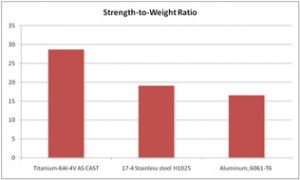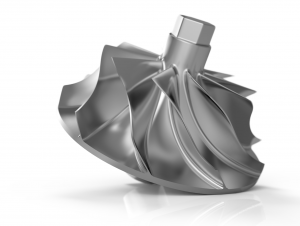Light Weight Titanium Aerospace Castings
For nearly 50 years, FS Precision has supported the Aerospace Industry with high strength and low weight, near-net and net shape titanium castings.
 For Ground, Sea, Air and Space applications FS Precision Tech produces titanium components with reliability and safety margins to maximize operational effectiveness. Equipped with FSPT cost-effective titanium castings, mission critical aerospace components resist even the most extreme forces – whether cyclic or static – without the weight penalty associated with conventional metals.
For Ground, Sea, Air and Space applications FS Precision Tech produces titanium components with reliability and safety margins to maximize operational effectiveness. Equipped with FSPT cost-effective titanium castings, mission critical aerospace components resist even the most extreme forces – whether cyclic or static – without the weight penalty associated with conventional metals.
FSPT has invested decades developing and controlling our near-net casting processes to repeatably meet the stringent aerospace requirements for Ti6-4 (Gr. 5) and Ti6-2-4-2. We have also developed the proprietary FS2S titanium alloy specifically for high stress and high cycle applications to enable components to achieve tensile and fatigue strength equivalent to machined wrought titanium alloys.
The Challenges of Aerospace Design
This article focuses on the natural application of titanium to the aerospace industry, and our processes that make otherwise costly titanium affordable for aerospace applications. Particular attention will be paid to advanced aerospace applications which are already equipped with FSPT titanium castings.
The Weight Penalty for Aerospace Castings
Engineering design for the aerospace industry comes with a unique set of priorities and stringent requirements that must be adhered to. As engineers strive to meet these requirements, weight penalties are always in the forefront of their minds. Unnecessary weight significantly impacts both performance and total cost of deployment. While it is relatively straightforward to assert that less weight leads directly to improved performance and cost, let’s talk a little bit about the science and math behind this assertion.
Consider an aircraft in steady level flight. The Thrust (T) imparted on the aircraft must equal the Drag (D) acting on it in order to maintain steady flight velocity. The Lift (L) must equal the aircraft’s Weight (W) in order for it to maintain altitude. Therefore, we have:
From standard aerodynamic principles, these two relations may be modified to include Dynamic Pressure (q), Surface Area of the aircraft’s Wingspan (S), and Coefficients of Lift (CL) and Drag (CD).
A small math operation of dividing one equation by the other yields:
Equation 3 is the mathematical representation of the penalty applicable to unnecessary weight. It is clear that any weight increase must be balanced by an increase in thrust. Additional thrust means larger, more costly engines – and greater fuel costs. What’s more, increased thrust directly leads to increased loads and stresses, which in turn leads to larger structural components and further additional weight.
Thus, the cycle continues; a perpetual balancing act to achieve the optimum combination of performance, strength, reliability, and weight.
Faced with the need to minimize weight, designers might be inclined to use lightweight aluminum as a primary material. And Aluminum is, for many applications, sufficient. The ductile characteristics of aluminum, however – if used in the wrong applications – may allow cracks to propagate in certain high stress/loading environments. This issue leads us to another primary consideration for aerospace design: fatigue strength.
Fatigue strength

In addition to the static loads referenced in Equation 3, designers must also consider tremendous amounts of cyclic loading.
From the moment an aircraft’s engines are spooled up – whether the vehicle is for space or suborbital flight – many of its components are exposed to resultant vibrations. Design engineers are, therefore, tasked with designing components that will not suffer from a loss of strength due to cyclic loading – also known as fatigue degradation. This fatigue degradation takes form as aerospace castings are subjected to a pattern of loading and unloading at stresses below ultimate tensile for hundreds of thousands of cycles – or high cycle fatigue.
In the case where components are subjected to the vibrations of flight, problems may begin with crack nucleation at local stress concentrations and imperfections. Once a microscopic crack has been initiated, it may continue to grow as stresses are repeatedly applied through cyclic loading.
Simulation of this loading can be performed in a laboratory environment by applying a distinct Stress Range (ΔS) to a sample for a set Number of Cycles (n), thus producing what is known as an S-n Curve. This curve may then be used to estimate the growth of the Crack Length (a). This growth appears as the Crack Growth Rate (da/dN), or change in length over change in cycles. For predicting fatigue failure, the Stress Concentration (K) for a particular Geometry Function (µ) is established, and then the growth of the crack may be characterized by equations 4 and 5 below:
[Eq. 4]
da/dN = A(∆K)n
[Eq. 5]
∆K=∆S√ πa∝
From these relationships, you might recognize that the lower the stress concentrations, the lower the chances are for crack formation and growth. Porosity and voids are notorious contributors to stress concentrations; as are rough and uneven surfaces created from grinding and machining. Soft or ductile materials, such as aluminum, tend to allow cracks to spread more quickly, leading one to believe that the use of higher strength materials should reduce stress concentrations and consequent crack propagation.
If stronger materials lead to improved fatigue resistance, why not opt for high strength steel for all aerospace castings? Circle back to the previous discussion regarding static loading where increased weight comes with a penalty, and the puzzle of aerospace design and material selection begins to become clear.
Design Tradeoffs for Aerospace Metals
 Aluminum may be considered for its ease of manufacturing and low weight, and steel for its exceptional strength and fatigue qualities. Many of the benefits of one, however, are absent in the other. Steel alloys far exceed the mechanical properties of aluminum, yet their relatively high weight carries the performance penalties illustrated in equation 3.
Aluminum may be considered for its ease of manufacturing and low weight, and steel for its exceptional strength and fatigue qualities. Many of the benefits of one, however, are absent in the other. Steel alloys far exceed the mechanical properties of aluminum, yet their relatively high weight carries the performance penalties illustrated in equation 3.
This leads to the classic weight vs. strength question where additional aluminum must be used to meet required stress margins, or be substituted altogether by steel. In either case, design engineers must pay the price for this additional strength with a weight penalty.
The exact cost associated with this additional weight varies from craft to craft within the aerospace industry, but consider this: According to Business Insider, the cost of cargo or extra weight for NASA’s Space Shuttle program and the SpaceX Dragon is an impressive $10,000 per pound. Some communications satellite manufacturers have put this penalty at more than $35 per gram – or in excess of $15,000 per pound. Clearly, weight can be equated with cost, and FSPT near-net titanium castings reduce that burden while assuring the achievement of mechanical reliability objectives for mission critical system components.
The Advantages of Titanium
Titanium’s relative high strength-to-weight ratio versus steels and aluminum alloys has paved the way for its prominence in aerospace. With a near ideal combination of low weight and high strength, titanium has the unique potential to satisfy many demanding aerospace requirements.
Titanium’s ideal application for aerospace castings stems from its unique atomic structure. Titanium has an atomic mass of 47.8 atomic mass units (amu). Whereas iron, which is known for its high strength properties, has an atomic mass of 55.8 amu. From a pure mass perspective, one might expect a cubic block of titanium to weigh only 17% less than the same sized block of iron. This is not the case, however. In fact, typical steel alloys weigh nearly 80% more than titanium alloys. If the atomic mass of the two are so nearly equal, how can this be?
The answer lies in the structure of titanium’s electron shell. A standard molecular measurement of bonded metal atoms is the Metallic Diameter, or the mean distance between the nuclei of the atoms. For titanium, this measurement is 294 picometers (pm), whereas in an iron crystal structure, the distance is 252 pm.
This atomic structure leads titanium to be classified as a “Transition Metal”. Titanium atoms form strong covalent bonds due to the electrons available for bonding – or valence electrons – being present in more than one shell. This allows titanium atoms to share electrons, as opposed to aluminum and steel molecules that form delocalized bonds where multiple atoms are influenced by electron clouds. Titanium’s bonds are stable and exceptionally strong in both pure titanium and in its alloyed forms, allowing it to retain an incredible amount of strength while at the same time remaining comparatively lightweight.
Ti6-4 Grade 5 for Aerospace
The current industry standard for titanium use in aerospace applications is Ti6Al4V, or Grade 5 Titanium (Ti64). Ti64, and titanium in general, is not without drawbacks. The primary drawback being the typically high cost of titanium in its refined form. In spite of the relative abundance of titanium in the world – it is the 9th most abundant element, and makes up more than 0.5% of the earth’s crust – it is costly to extract and refine into its pure usable form.
In its wrought and machined form, extraordinary amounts of resources are committed to the multiple processes required for initial heating and forming, followed by the associated machining costs and finishing to produce a final product. While these time consuming and costly processes yield an extremely mechanically resilient version of titanium with excellent strength and fatigue properties, they are often not practical due to the cost.
In order to offset these costs, designers have the option to produce titanium castings. However, standard cast Ti64 sacrifices some tensile and yield strength in exchange for reduced machining and material quantity costs. Wrought Grade 5 titanium, for example, typically achieves 140ksi and 130ksi for tensile and yield strength, respectively. Its cast counterpart typically achieves levels of approximately 135ksi and 122ksi, respectively. Cast Ti64 typically also has a lower fatigue strength than that of wrought Ti64.
With that in mind, FSPT has developed a titanium alloy to include the cost-effective approach of near-net casting while retaining the mechanical properties of wrought and machined components. This resulted in our advanced FS2S titanium alloy.
The Better Titanium for Strength and Fatigue

FS Precision Tech’s advanced FS2S titanium alloy
checks off every mechanical property that an aerospace application requires. Through alloying with aluminum, vanadium, chromium, and other elements, FS2S has improved the mechanical properties for cast titanium to a level significantly higher than that of cast Ti64 (Gr.5), and virtually equivalent to that of machined wrought titanium alloys..
Cast FS2S has ultimate tensile strengths and yield strengths of 148ksi and 135ksi, respectively. With elongation of nearly 40% higher than cast Ti64, FS2S is an ideal material for critical applications where catastrophic mechanical failures might have extreme consequences.
In addition to being on par with fully machined conventional wrought titanium alloys, FS2S has double the strength of typical aluminum alloys, and is 40-50% lighter than conventional steel alloys. These superior properties for aerospace castings are made possible by the unique microstructure of FS2S alloy. Standard Ti64 castings yield a hard and brittle outer layer known as alpha-case, which tends to introduce micro-cracks into the surface structure of castings, and thus can lead to fatigue degradation. The FS2S compound and microstructure, however, yields a beta rich final product which reduces the as-cast alpha case by a factor of two. This can reduce the amount of costly chemical milling required, as well as reduce the potential for Hydrogen uptake during the chemical milling process.
FS2S Titanium aerospace castings combine Low weight, high strength, and fatigue properties with a cost-effective casting process, while achieving the mechanical properties of fully machined wrought Ti64. With our FS2S titanium alloy, designers can take advantage of every one of these benefits, in the design of a near-net casting.
If you would like to investigate the potential for applying these benefits for your applications, please download our FS2S Titanium Data Sheet, or contact us now.
FS Precision Near Net Casting
FSPT delivers titanium’s superior strength to weight ratio and fatigue resistance through a process known as near-net titanium investment casting. Our proven method ensures that you receive dimensionally compliant components while reducing material waste and excessive machining that can otherwise drive up the costs associated with fully machined wrought titanium applications.
This cost-effective process begins with our using your design to create an exact wax copy – “pattern” – via an injection molding process or 3D Printing. Next, we coat the wax pattern with several layers of a ceramic slurry mix, and allow it to dry. We then remove the pattern, leaving behind a mold in the shape of your complex component design. Finally, fill the mold with molten titanium. The ceramic mold is then destroyed to allow removal of the titanium casting.
Typically, we then follow the casting process with a series of additional post-cast processes, inspections, and certifications until your cast titanium component is ready for its final quality inspections and release for shipment.
When designing components for the rigors of aviation, two primary concerns tend to be in the forefront of the engineer’s mind: 1) component strength/fatigue and 2) tight tolerances. At FSPT, we systematically address and resolve these and many other potential concerns.


We are AS9100 and Nadcap certified, and adhere to strict aerospace casting specifications of AMS 4991, AMS 4992, AMS T-81915A, as well as many custom specifications imposed by our large number of aerospace castings customers.
Following removal of the casting from its ceramic mold, it is typically put under extreme temperature and isostatic pressure – up to 15,000 psi – in a process known as hot isostatic pressing (HIP), to collapse any internal voids which may have formed during casting. Following HIP, we perform in-house chemical milling to remove the hard alpha-case layer generated by the high temperature conditions of casting. This chemical milling is performed by our in-house approved chemical milling system.
In their as-cast condition, our casting process can achieve very good as cast tolerances for many applications. We offer the option of performing finish machining in order to deliver final component precision surfaces if required.
FS Precision implements the highest level of Continuous Improvement and 6 Sigma process control methodologies available in the industry, and we hold ourselves to extremely high quality standards maintained through aerospace inspection specifications and accreditations.
Our process of near-net casting and machining ensures that no time or unnecessary expense is wasted machining or converting costly titanium into dirty scrap chips on the floor. For many of our casting projects, a fully machined version may otherwise have begun as a 100-pound billet, and then been machined down to a finished geometry of five pounds or less. That’s money spent on wasted titanium and excessive machining operations! At FS Precision Tech, we like to say that “We put the air in your parts so that YOU don’t have to.”
FS Precision Experience with Titanium Aerospace Castings
Aerospace Valves and Manifolds

As we’ve stressed up to this point, our cost-effective cast titanium is ideally suited for the demanding field of aerospace design. Critical hydraulic systems, for example, operate under especially stringent requirements where any small failure within a valve or manifold can lead to significant damage or a complete system failure.
To prevent these failures, hydraulic systems must withstand thousands of flight hours and all the fatigue and potential damage that accompanies those hours. It was precisely this challenge that caused one of the leading aerospace motion & control companies to partner with FSPT to develop the exact titanium valve components required for a reliable premier aviation anti-icing system.
One solution to prevent ice buildup on the leading edges of an aircraft is to provide a steady supply of anti-icing fluid to those edges. However, an effective system must maintain a precise flow-rate of fluid, as too little flow can lead to a wholly ineffective system, resulting in damaging ice buildup. Conversely, too high a flow-rate may potentially lead to corrosive anti-icing fluid damage elsewhere on the aircraft.
Naturally, precision paired with unyielding strength and reliability were crucial for the success of this project. One without the other could easily lead to one of two outcomes; first, an imprecise and leaking valve where free fluid could cause thousands of dollars’ worth of damage. Or second, a valve unable to withstand the continuous fatigue and strength requirements placed on the system, leading to a failure of the anti-icing system.
FSPT delivered on both requirements – and more – with our near-net aerospace castings delivering unwavering reliability to our customer’s system through our cost-effective quality-certified processes.
FSPT’s rigorous process control and quality systems ensures that every valve serves as an example of our commitment to providing customers with an affordable avenue to the strength and precision required for the aerospace industry. without the usual weight penalty associated with such benefits.
The application of FSPT near-net aerospace castings excels far beyond even the field of aircraft. The beneficial impact of titanium alloys can be felt tenfold in even more weight critical space applications where an investment casting can be extremely competitive, even in lower volumes.
As previously discussed, the cost of a single pound of weight added to a spacecraft can pin tens of thousands of wasted dollars to a single launch. In addition to the compounded weight penalty, the components within these craft are subjected to incredible loads, both static and cyclical. This leads to a design process where reliability is paramount, strength is critical, and lightweight is a major budgetary and operational consideration. These were the requirements brought to FSPT by a major leader in the race to spaceflight and space tourism when designing their craft’s fuel system.
Naturally the requirements and standards for a spacecraft’s fuel system demand perfection from the quality of material, to its mechanical properties, all the way to the dimensional precision of the final component.
This system must exactly control fuel flow to accommodate precise adjustments to velocities during the craft’s launch and return from and to Earth. That alone requires aerospace castings that can maintain exceptionally tight tolerances.
Achieving these milestones in a cost-effective manner was no small task. However, FSPT’s near-net aerospace casting components managed to do exactly that. Seamlessly blending the mechanical properties of our cast titanium with a proven cost-effective process; we continue to produce the intricate channels and geometry required for fuel system valves and manifolds. Our aerospace castings offer creative design flexibility that enable what might otherwise be two or more machined subsystems welded together to be cast as one solid, robust, integral component or system.
Titanium Casting Mounts & Housings

Fluid control is only one of a many application for our titanium aerospace castings. The excellent fatigue strength of titanium investment castings can also be harnessed to create built-in reliability for critical cast components able to withstand flight loads.
Flight Data Recorders, for example, must continue to function regardless of the jolting or shuddering motion that may be encountered during certain mission profiles. Nearly every component within these modules is susceptible to performance loss with exposure to continuous fatigue. What’s more, cockpit data storage units must be designed to survive complete aircraft failures where the majority of other aircraft systems and components will be a complete loss. FSPT’s titanium aerospace castings are currently being utilized to provide the precise and rugged protection these sensitive electronics require.
Additionally, with the use of FSPT FS2S alloy, that strength can be nearly 10% greater than standard aerospace alloys such as Ti64 Grade 5.
Any component designed to be located near, or mounted to the engine is subject to cyclic stresses due to vibration and loading caused by the natural operation of the engine. This fatigue loading is exacerbated by the higher loads associated with extreme aircraft maneuvers such as takeoff and landing.
Engine structural components represent an ideal application for titanium’s unique characteristics. Improved ductility and fatigue strength will ensure no strength loss over the life of the airframe.
The Bottom Line
We receive few luxuries during the design process for the aerospace industry. Primary components must possess superb mechanical properties, maintain exceptionally tight tolerances, and all the while keep weight and cost to a minimum. Ordinarily, these requirements would be exclusive of each other, where inefficient machining operations and costly weight penalties might prevail. Our AS9100 certified aerospace titanium castings, however, are no ordinary castings!
FSPT enables the technology to merge high tensile and fatigue strength with reduced weight into a single high quality highly reliable component that minimizes material waste and maximizes your returns. Contact us, and we’ll work directly with your team to develop aerospace castings that meet all your needs to keep your mission critical systems performing reliably!

